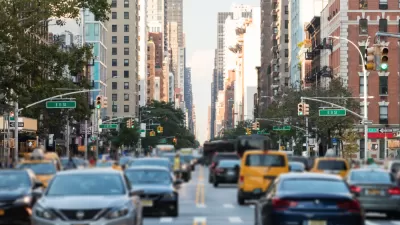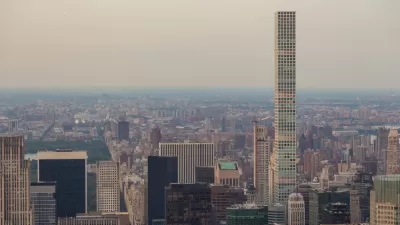Moving an 80,000-pound metal box means using energy, and elevators can account for 2-10% of a buildings energy use.

There are about 7.6 billion people on earth and, according to Smithsonian Magazine, those people take more than 7 billion elevator trips every day. That vertical movement costs energy and the need adds up quickly. "Newer elevators already incorporate green features such as LED lights, water soluble paint and recycled construction materials, but many companies have begun to explore a wide and somewhat outlandish array of alternatives to the traditional rope-and-pulley systems of a hundred years ago," Adrienne Bernhard reports for the Smithsonian Magazine.
An elevator can weigh 4 tons, consuming energy even when it's not in use. "In fact, elevators typically account for between 2 percent and 10 percent of a building’s energy use," Bernhard reports. But regenerative drive systems that reclaim some of the energy they use has cut into that energy cost for some new elevator designs. There are also machine room-less elevators, which allow for flat roofs, that are easier to use for solar power generation. "In 2017, Thyssenkrupp Elevator became the first company to retrofit an existing elevator to achieve net-zero energy," Bernhard writes.
FULL STORY: Elevators Are Going Green

Planetizen Federal Action Tracker
A weekly monitor of how Trump’s orders and actions are impacting planners and planning in America.

Congressman Proposes Bill to Rename DC Metro “Trump Train”
The Make Autorail Great Again Act would withhold federal funding to the system until the Washington Metropolitan Area Transit Authority (WMATA), rebrands as the Washington Metropolitan Authority for Greater Access (WMAGA).

DARTSpace Platform Streamlines Dallas TOD Application Process
The Dallas transit agency hopes a shorter permitting timeline will boost transit-oriented development around rail stations.

Car-Centric LA Suburb Looks to a Train-Oriented Future
City leaders in Rancho Cucamonga, the future western terminus of the Brightline West rail line to Las Vegas, want to reimagine the city as a transit-oriented, pedestrian-friendly community.

New Alaska Bitcoin Mine Would Burn as Much Energy as the State’s Largest Coal Plant
Fueled by “stranded” natural gas, the startup hopes to become the largest in the US, and to make Alaska an industry center.

New Jersey Duplexes Elicit Mixed Reactions
Modern, two-unit residences are proliferating in northern New Jersey communities, signaling for some a boon to the housing supply and to others a loss of historic architecture.
Urban Design for Planners 1: Software Tools
This six-course series explores essential urban design concepts using open source software and equips planners with the tools they need to participate fully in the urban design process.
Planning for Universal Design
Learn the tools for implementing Universal Design in planning regulations.
Municipality of Princeton
Roanoke Valley-Alleghany Regional Commission
City of Mt Shasta
City of Camden Redevelopment Agency
City of Astoria
Transportation Research & Education Center (TREC) at Portland State University
US High Speed Rail Association
City of Camden Redevelopment Agency
Municipality of Princeton (NJ)





























